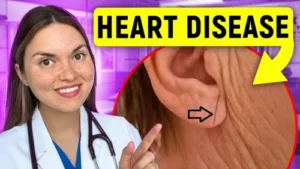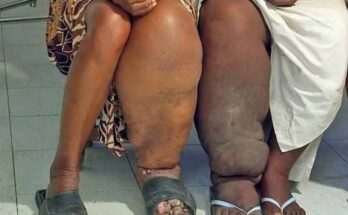
Did you know that your skin, nails, eyes, and even your ankles could reveal important information about your heart? Heart disease is extremely common and it often progresses silently. And it’s not just chest pain and heart attacks. There are many types of heart disease that can take you by surprise. Today, I’m going to show you 13 signs of heart disease that you can see and test on yourself right now at home. So, let’s dive right in. Starting with Frank’s sign. This is a diagonal crease running across the
earlobe that could be a sign of vascular aging. The earlobe is a great place to look for vascular aging because it’s a fat-free region of skin that’s supplied by tiny blood vessels. If it’s stiffening, wrinkling, and folding prematurely, it’s a sign that those tiny blood vessels may not be healthy. And the concern is if these changes are happening in your earlobes, then chances are that it’s also happening in the blood vessels of your heart. But it’s controversial because earlobe creases
also are more common as you get older. So when should you be concerned? In general, it’s more concerning if you have deep creases that run all the way across both of your earlobes. Just remember that Frankstein is far from perfect. So I personally think of it more like a conversation starter rather than a diagnosis. Okay. Now let’s shift our attention to the eyelids. See these flat yellowish patches near the corners? These are clumps of fat and cholesterol under the skin called zanthalasma.
Basically, when cholesterol levels get too high, it starts to deposit into your tissues and then scavenger cells called macrofasages start chewing it up. But if they eat too much cholesterol, they turn into these bloated foam cells. So when you see zenthalasma, you’re actually looking at a cluster of overindulgent macrofasages. Once again, the concern is that these skin findings reflect what’s going on in the heart. Similar plaques made of those foam cells can form in your coronary arteries, slowly growing
and blocking off the blood supply to your heart. That’s what happened to this 40-year-old woman who came to clinic with exertional chest pain. And it did not take long to figure out the cause. She had so much zenthalasma that it almost looked like she was wearing glasses. We actually call this pseudo spectacles. She also had large lumps on her hands and feet called tubra xenthoma which are also formed by cholesterol deposits. This was caused by a genetic condition called familial hyper cholesterolmia that resulted in
extremely high cholesterol levels. And it turned out that she had so much plaque buildup in her heart by the age of 40 that she required open heart surgery to restore circulation. And get this, even if you have normal blood cholesterol levels, zanthalasma should never be ignored because research shows us that you still have a higher risk of cardiovascular disease and death. So if you see zanthalasma, take it as a cue to talk to your doctor about screening for genetic conditions and how to lower your
risk of cardiovascular disease. While we’re on the topic of cholesterol deposits, another good place to look is your eyes. See the grayish white circle around this woman’s iris? That’s called coral arcus. Almost everyone will develop this as we get older, but if it shows up before the age of 45, that’s a red flag to make sure you get your lipid levels checked. So, as you can see, your skin can tell you a lot about your heart. But it’s not always about cholesterol. These bumps around the eyes
are caused by a group of conditions called amalloidosis. The most common type is al amaloidosis where your bone marrow produces a huge amount of misfolded proteins called amalloid. These proteins clump together and can deposit into the heart muscle causing it to become stiff and thick, a condition called restrictive cardiammyopathy. Early diagnosis and treatment is key. You don’t want to wait around for symptoms of heart failure, which is why identifying these skin findings is so important. Start by checking your skin
for waxy, translucent, firm bumps that you’ll likely see around the eyes, ears, and neck. Next, take a look at your tongue. Amalloid can deposit there, too, causing it to grow in size. This is called macro glossia, and I always look for indentations along the side of the tongue because as it gets bigger, it presses up against your teeth. And finally, a classic sign to watch out for is raccoon eyes. This happens because amaloid weakens your tiny blood vessels. So even gently rubbing your eyes can
cause these vessels to break and lead to dramatic bruising like this. Next, let’s talk about liido reticularis which is a net-like pattern on the skin which is a sign of poor circulation. The reddish blue color of the pattern is caused by constricted or blocked blood vessels while the rest of the skin maintains a normal appearance. But it’s actually not always a bad sign. In fact, it’s really common to see it in healthy babies or even in young women whose blood vessels are constricted when they’re cold. But
the key is that it doesn’t cause any pain and it goes away when they warm up. On the other hand, it could mean that small pieces of cholesterol plaque in your arteries have broken off and become lodged in the tiny blood vessels in your skin. This is called a cholesterol embolism. But that’s not the only reason to be concerned. As a rheatologist, I’ll often see this in life-threatening autoimmune conditions like lupus or antifphospholipid syndrome. So, as a general rule, if your skin takes on this
appearance and it doesn’t go away when you warm up and especially if it causes other symptoms like pain or skin ulcers, you need to talk to your doctor. Okay. Now, take a look at these fingernails. Can you see those pulsations? That’s called Quinky’s sign. Normally, your heart pumps blood out to the rest of your body through a one-way valve called the aortic valve. If that valve becomes leaky, blood flows back into the heart between pumps, a condition called aortic regurgitation. And when blood
flows back into the heart, it leads to a rapid drop in pressure, which causes these visible pulsations. And it’s not just the nails. You can see these pulsations all over the body. Here’s Coran’s sign where you see these dancing corateed arteries. This is Demuse sign where you can see a subtle head nod with each heartbeat. This is Mueller sign where you can see the uvula at the back of the throat pulsating which I’ve got to say is pretty wild. And Lenduli sign where pupils constrict and dilate with
each heartbeat. Left unchecked, aortic regurgitation puts a huge amount of stress on your heart and can lead to heart failure. Which brings us to our next topic. Heart failure is a state where your heart becomes damaged and it can no longer pump blood effectively. This can happen if the heart muscle becomes too weak like after a heart attack or if the heart muscle becomes too stiff like an amaloidosis. Now, one of the most obvious signs of heart failure is a type of swelling called pitting edema that you can usually find
in the feet and ankles. But don’t be fooled. This doesn’t always mean heart failure. In fact, these days I can even get some pitting edema by the end of the day if I don’t wear compression stockings. Fortunately, that’s not because of heart disease, but it’s because I’m in my third trimester of pregnancy. Surprise. All right, back to pitting edema. Here’s a simple way you can check for it on yourself. Press your fingertip firmly into a bony area of your lower leg, either your shin or your ankle, for
about 5 to 15 seconds. If this leaves a visible indent on your skin, that’s pitting edema. So, why does this happen in heart failure? Well, when your heart isn’t pumping effectively, fluid starts to back up and accumulate in your body. Think of it like a car accident that causes a traffic jam. You get congestion on the highway, so people start exiting and going on smaller roads to avoid the traffic. The same thing happens in your body. If your heart isn’t pumping effectively, fluid starts to back up,
leading to congestion and increased pressure in your veins, which then leads to fluid seeping out into your tissues. Left unchecked, severe pitting edema can lead to skin breakdown and infections, but it’s usually not life-threatening. On the other hand, the main reason that I see patients in the hospital admitted with heart failure is when fluid builds up in their lungs. It’s called pulmonary edema, and this is what it looks like on a chest X-ray. When your lungs get filled with fluid like this, the most
common symptom is orthopia, which means shortness of breath that’s worse when you’re lying down. It’s actually pretty common for patients to tell me that they’ve started sleeping in a recliner chair because it helps them breathe better. Fortunately, we have really effective ways to clear out that excess fluid and dry up those lungs. In fact, in the hospital, under close monitoring, we can use medications to help someone pee out upwards of 10 to 20 lb of excess fluid in a matter of days. But heart
failure isn’t just about fluid leaking into your legs or lungs. The increased pressure in your veins can also lead to issues with your kidney and liver as well. I find that people are usually quite surprised to learn that heart failure can lead to cerosis and even liver failure. Now, there are a lot of physical signs that show up when your liver isn’t working properly, from abdominal swelling to skin and nail changes. I’ve got a whole video dedicated to exploring those signs in detail. So, I’ll leave a link below so
you can check that out next. Okay, now for another test. Put the backs of your nails together like this. If you can see a triangle of light between the nails, that’s normal. But if you can’t, that’s called digital clubbing. It’s most often a sign of chronically low blood oxygen levels. But it can also be from other factors that stimulate abnormal tissue growth in the fingertips. And there are many causes from chronic lung disease to bowel disease and as you probably guessed, heart disease. The most common
examples are heart birth defects, which are typically picked up in childhood. But when I see it in an adult, it could be a sign of an infection in the heart called infective endocarditis. Infective endocarditis usually refers to an infection of your heart valves. If certain bacteria or fungi end up in your bloodstream, they can latch on to your heart valves and form these little clumps that we call vegetations. And these vegetations are literally flailing around on the valve as it opens and closes. So, if you’re thinking that
looks kind of precarious, you’re absolutely right. Little chunks can break off and travel through the bloodstream until they get lodged into tiny blood vessels downstream. If they get lodged in the pads of your fingers and toes, they can cause these painful raised bumps called osler nodes. Or it can cause painless flat red or purple spots on the palms or soles called Janeway lesions. And perhaps one of the most recognizable signs is found on the fingernails called splinter hemorrhages. These reddish brown streaks that look
like wood splinters are actually tiny blood clots in the nail bed capillaries. But seeing a splinter hemorrhage doesn’t always mean infective endocarditis. For example, this person has a splinter hemorrhage from trauma, just hitting their nail against something. And this person has them from an autoimmune skin condition called psoriasis. In comparison, infective endocarditis usually causes splinter hemorrhages to form on multiple nails. And you’ll usually have other symptoms like fever,
weight loss, or feeling just generally unwell. Now, when’s the last time that you felt your own pulse? Take a moment and check the rhythm. Does it feel regular and predictable, or is it completely random? There’s one very common form of cardiac arhythmia that’s so important to detect that many smartwatches are designed to send an alert if it’s detected. It’s called atrial fibrillation and it leads to a random irregular heartbeat. To understand atrial fibrillation, you need to know that the heart has four
chambers. Two ventricles which are the main pumps and two atria which are the primers. They give a little extra squeeze of blood into the ventricle before it pumps making it work more effectively. Now the atria have pretty thin walls compared to the muscular ventricles and if you have high blood pressure they can get stretched out over time. This can disrupt the electrical system that coordinates contractions. So instead of the atria pumping in sync with the ventricles they just sort of start twitching aimlessly and without
steady contractions blood in those upper chambers can become stagnant and form blood clots. And the real danger happens when that blood clot breaks free, enters the ventricle, and gets pumped out into your circulation. This scenario is far more common than you might think, and it’s one of the major causes of stroke. So, if you or someone you know has an irregular heartbeat, even if it comes and goes, it’s something you need to get checked out. Ahib is easy to diagnose on a heart monitor, and treatment with a
blood thinner can dramatically lower your risk of having a stroke. So, after hearing all this, if you’re feeling motivated to improve your cardiovascular health, I’d suggest watching these two videos next that talk about how to lower your blood pressure and cholesterol naturally. As always, stay curious, stay healthy, and I’ll see you in the next video. So, bye for now. [Music]

